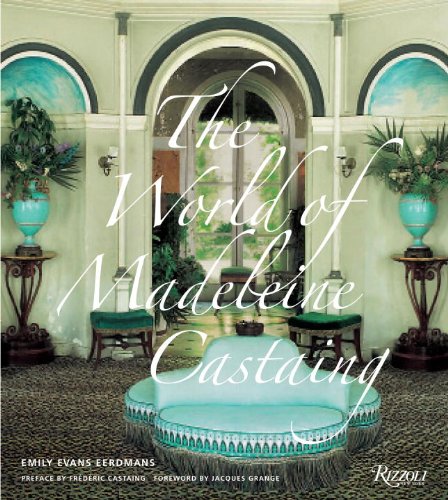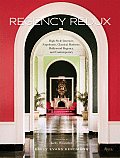 The original Loop Chair at Ditchley Park
The original Loop Chair at Ditchley ParkI have been greatly anticipating the January issue of the Magazine Antiques. Its new editor Betsy Pochoda (formerly of House and Garden) has gradually been making changes since May 2008, but finally in this month's issue we get to see its much-talked about redesign.
Another seismic shift in the magazine has been Pochoda's inclusion of mid-century design, which, frankly, is about time. When Leigh Keno, American furniture dealer and Antiques Roadshow poster boy, starts slipping in 1950s Italian furniture alongside an 18th Philadelphia School tallboy, you know things are a-changing.
One article in particular will make you want to consider giving the magazine a closer look: "The It Chair" by Shax Reigler. It chronicles the history of what many have dubbed the Frances Elkins Loop Chair through the eyes of design sleuth James Shearron of the architectural firm Bories and Shearron. Bories explains his fascination with the chair: "They appear to be made from one continuous unbroken line and that's very alluring. It also walks that line between modern and traditional design which is something we play with in our own work."
 first picture of the Loop Chair in the Dictionary of English Furniture, 1904-1908
first picture of the Loop Chair in the Dictionary of English Furniture, 1904-1908 18th century English side chair in the collection of the Victoria and Albert Museum, London; the articulation of loops on the back of this chair in which you can see their overlapping as well as how they shape the back is based on the designs of William de la Cour and is the closest precedent for loop-back chairs. However there is no direct design source for the Elkins chair found to date
18th century English side chair in the collection of the Victoria and Albert Museum, London; the articulation of loops on the back of this chair in which you can see their overlapping as well as how they shape the back is based on the designs of William de la Cour and is the closest precedent for loop-back chairs. However there is no direct design source for the Elkins chair found to date
 Mr. and Mrs. Wheeler's living room in Lake Forest, Illinois in a photograph by Ezra Stoller, circa 1934
Mr. and Mrs. Wheeler's living room in Lake Forest, Illinois in a photograph by Ezra Stoller, circa 1934 A pair of George III painted armchairs, circa 1800, from the archives of Hyde Park Antiques, were light enough that they could be carried inside and out
A pair of George III painted armchairs, circa 1800, from the archives of Hyde Park Antiques, were light enough that they could be carried inside and outShearron came across this mid-century cast-iron pair (which most certainly were painted white) intended for the outdoors, and furthermore remembers seeing the loop chair in terrace settings in Hollywood films of the 30's.


A loop chair in the country house living room of Albert Hadley
Another feature Bories and Shearron will be certain to include is the dipped seat, which Elkins also replicated in her versions (which is a good tip to look for if something is represented with an Elkins provenance). "The opportunityto see this delicate calligraphic-like object married with our architecture would be very cool. We love them in black like the originals, or even a dark mahogany. A full set around a dining table or a few in a hallway - they really can go anywhere." And that's a recipe for a classic, if I ever heard one.
UPDATE: This April, Sotheby's New York will be offering the Elkins Loop Chairs designed for the Leslie Wheelers. This is a rare opportunity to own documented Elkins chairs - how much will they go for?
UPDATE II: http://www.themagazineantiques.com







13 comments:
Be still my heart ~ I love that cast iron pair. What a great piece Emily! I will stop to get a copy of the magazine on the way home this evening.
Fabulous post Emily. Really outstanding. And I LOVE your new header and profile picture!
Janet, the cast iron really captures the fluidity of the lines, doesn't it? EEE
Thanks, Courtney! PVE is amazing - I thought people might worry about me if they knew I have 3 cats in a NY apartment, but she convinced me to go for it!
Loop de loop, those chairs make my head spin.
They do remind me of calligraphy, in black india ink.
Thanks for the info Emily on the Loop chair. Seems like so many copies are recently being made (especially in LA). Thanks for the tip on the dipped seat.
You're welcome, Soodie - even though I certainly appreciate a good reproduction if it's just a look I'm after, it's amazing how the details - like the dipped seat - can make a tremendous difference.
Hoping you're not weary of the phrase "Wonderful Post", since that's how I reacted to this one. As many times as I've gazed at that Serebriakof of the small writing room at Ditchley, the loop back chair wasn't registering in quite the way it does here. Love this sort of lesson.
Nevah, Mr. Worthington! But I do owe a great debt to fellow design enthusiast James Shearron for helping pull this together. EEE
ooooooooooooh, i think i have a new obsession! loooooooooop chairs!
Lynne, your obsession makes perfect sense…
The "Loop Chair" really is a rather interesting decorative arts phenomenon- in design and popularity. This curiosity is one those special moments in the arts when some unknown craftsman got it just so right. That moment when pure form and the clarity of a single idea come together in a unique way unlike anything else before it or after it. It's 18th century date making everything about it from its construction to its modernity even more surprising. And, there are only just the 5 original models known to be in existence.
ANITQUES MAGAZINE has just put up an interesting "postscript" to their "IT" chair piece on their new website under the heading NEWS & OPINION. It is a charming interview with the owner of a documented set of 4 Frances Elkins Loop chairs purchased directly from the original owner. They are in fact quite possibly the only 4 F.E. Loop Chairs in existence. Below is the link.
www.themagazineantiques.com
I'm not sure how I found this post, but I am so glad that I did! What a beautiful chair. I love the comments by J. Shearron.
Post a Comment